FSC calls for modernisation in super development



Removing barriers for superannuation funds to transition to modern investment products would result in members retiring with cumulatively $16 billion more by 2050, according to the Financial Services Council (FSC).
The FSC’s Product Modernisation Research Report, prepared by EY, also found it would lift their collective retirement income by $22 billion during their retirement.
Product modernisation refers to the rationalisation of products and investment structures in a pragmatic and efficient manner by trustees (responsible entity or responsible superannuation entity) in the best financial interests of members or investors.
The report stated: “Outside of a successor fund transfer (SFT), whereby a whole superannuation fund is transferred to another and CGT relief applies for all members, there is no existing, viable mechanism that enables trustees of superannuation funds and managed investment schemes (MISs) to efficiently rationalise products and investment structures. This creates an uneven playing field that only promotes efficiencies in a subset of scenarios.
“Consequently, the proliferation of products that could benefit from ‘modernisation’ is creating system-wide inefficiencies, with our research indicating negative consequences for all stakeholders. The recent application of the annual performance test (APT) to trustee directed products is expected to increase the rate at which the modernisation challenge grows.”
The report found that an individual aged 40 with a current balance of $80,000 could have an additional $198,676, from $484,005 to $683,689 by the time they retire in 2050 if super trustees were permitted to move them to contemporary products without incurring tax penalties or regulatory barriers if they are currently invested in a legacy product.
“A product modernisation regime would support the government’s fiscal position, by lowering government age pension outlays and raising new tax revenue, by almost $1 billion in the next decade, without having to raise new taxes on superannuation consumers,” FSC chief executive Blake Briggs said.
However, barriers to modernisation include capital gains tax impacts, obtaining member consent and consent to modifying member rights.
There are four groups of people the report found would benefit from the changes:
- Benefits to consumers including access to equivalent products with higher net investment returns driven by both higher expected investment performance and lower fee structures.
- Benefits to the government through greater tax receipts and savings due to reduced age pension payments.
- Benefits to trustees through operational and administrative efficiencies.
- Benefits to regulators through a more competitive industry, driving better outcomes for the consumer thanks to operational efficiencies.
Recommended for you
Economic growth was weaker than expected, once again highlighting an economy largely sustained by population growth and government spending.
In this latest edition, Anna Shelley, CIO at AMP, shares the fund’s approach to current market conditions and where it continues to uncover key opportunities.
The mega fund has announced a $2.2 billion investment in a leading data centre platform, bringing its global real assets portfolio to nearly $60 billion.
In this latest edition, Australian Retirement Trust’s head of global real assets Michael Weaver explains the fund’s approach to finding new opportunities as it surpasses $300 billion in funds under management.













